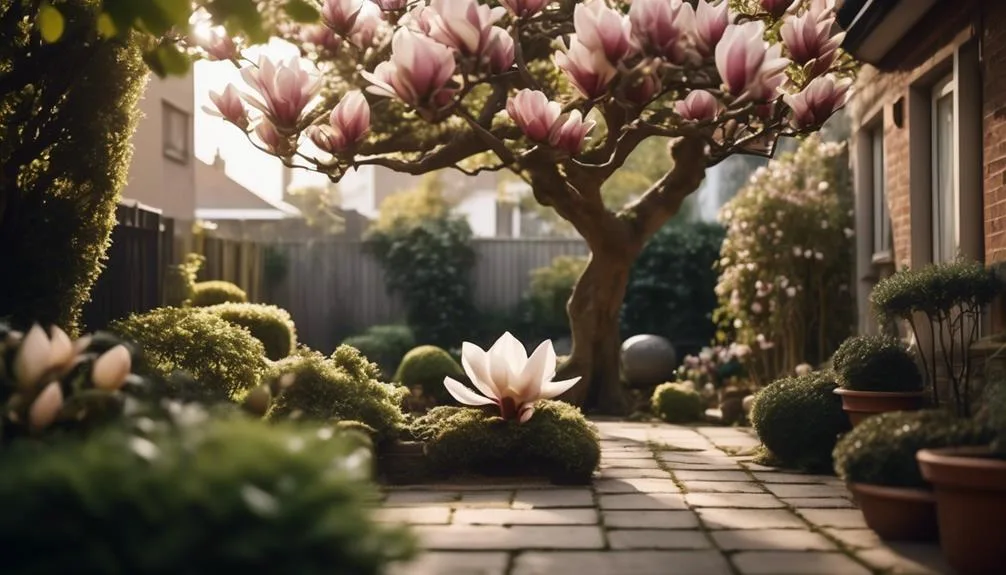Thinking about adding a magnolia tree to your small garden for a touch of elegance? Magnolia trees can bring beauty to compact outdoor spaces, but there are important factors to consider before deciding.
Understanding size and space requirements, as well as finding the right variety, is crucial. We'll explore how to incorporate these beautiful trees into your garden, covering everything you need to know.
Size and Space Requirements
When planting magnolia trees in small gardens, consider their size and space requirements carefully to ensure they thrive in their limited surroundings.
Magnolia trees have a wide root system that can potentially cause issues with surrounding structures and plants. It's important to plant them a safe distance from buildings, sidewalks, and other trees.
As for pruning and shaping techniques, regular maintenance is key to keeping the tree in check. Pruning should be done selectively to maintain the natural shape and promote air circulation. Avoid heavy pruning, as it can lead to an imbalance in the tree's growth.
Flowering and Aesthetic Appeal
To maximize the flowering and aesthetic appeal of your magnolia tree in a small garden, select a variety known for its compact size and abundant blooms. Some popular options include the Jane magnolia, which boasts vibrant pink-purple blossoms, and the Star magnolia, known for its star-shaped flowers in white or light pink.
These trees typically require well-drained, slightly acidic soil and thrive in full sun to partial shade. To maintain their aesthetic appeal, consider pruning techniques that promote a balanced shape and encourage new growth.
Magnolia trees offer seasonal blooms, with some varieties flowering in early spring and others in late spring to early summer.
With careful selection and maintenance, you can enjoy the stunning beauty of magnolia trees in your small garden, adding a touch of elegance and charm.
Maintenance and Care Considerations
Maximizing the flowering and aesthetic appeal of your magnolia tree in a small garden involves thoughtful maintenance and care considerations to ensure its continued vibrancy and beauty. Here are some important maintenance and care tips to keep in mind:
- Pruning Techniques: Regular pruning is essential to maintain the shape and size of your magnolia tree. Remove dead or damaged branches in late winter or early spring to encourage healthy growth and abundant blooms.
- Soil Quality: Magnolia trees thrive in well-draining, slightly acidic soil. Regularly test the soil pH and amend it as needed to ensure the optimal growing conditions for your tree.
- Watering and Mulching: Proper watering and mulching are crucial for the health of your magnolia tree. Keep the soil consistently moist, especially during dry spells, and apply a layer of organic mulch to retain moisture and regulate soil temperature.
Varieties Ideal for Compact Gardens
Looking for magnolia tree varieties ideal for compact gardens that will still provide stunning beauty and fragrance? Consider the 'Jane' magnolia, a compact shrub that blooms in early spring with vibrant purple-pink flowers. This variety is well-suited for small spaces and its smaller size makes it easier to manage.
Another excellent choice is the 'Ann' magnolia, known for its reddish-purple blooms and compact growth habit. Both 'Jane' and 'Ann' magnolias prefer well-drained, slightly acidic soil and regular watering, especially during dry spells.
When it comes to pruning techniques, it's best to prune these compact magnolia varieties immediately after flowering to avoid cutting off next year's blooms. This ensures that the trees maintain their beautiful shape and continue to thrive in your compact garden.
Conclusion and Final Considerations
Considering the compact growth habits and specific care needs of 'Jane' and 'Ann' magnolia varieties, it's essential to plan for their long-term health and beauty in your small garden.
When selecting a magnolia tree for your small garden, consider the ultimate height and spread of the tree to ensure it fits well within the space.
Additionally, think about the flowering season to ensure it aligns with your garden's overall design and color scheme.
Finally, pay attention to the soil and light requirements of the magnolia variety you choose, as these factors are crucial for its successful growth and blooming.
Conclusion
Incorporating a magnolia tree into a small garden is feasible with the right variety and care. Opt for compact options like Little Gem or Jane magnolia to bring beauty and charm to your yard.
Remember, with proper maintenance, these trees can thrive in limited spaces, enhancing your garden with their grace.
Happy gardening!
Mark Hoffman is a dedicated arborist and tree care specialist with over a decade of experience. His love for trees began when he visited Yosemite National Park as a teenager and was awestruck by the giant sequoias. Mark pursued his passion by studying forestry at Michigan Technological University, where he earned a Bachelor of Science degree.
Since then, he has worked tirelessly in the field of arboriculture, helping to preserve and protect trees in his community. His expertise and dedication have made him a respected leader in the industry and a valuable resource for anyone seeking advice on tree care.
